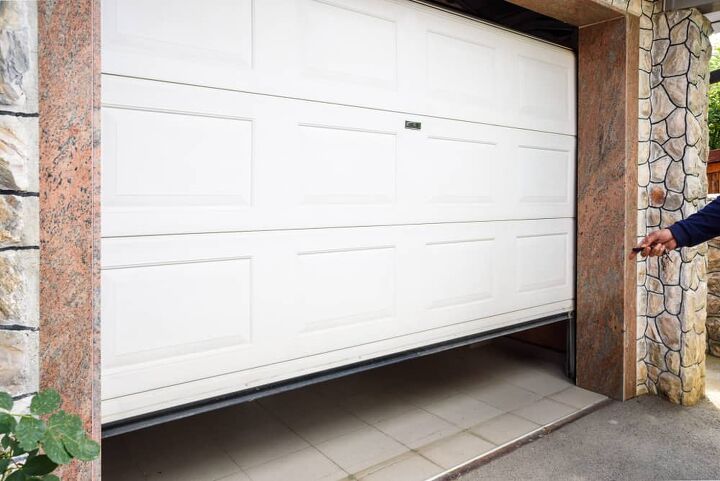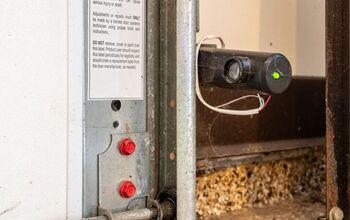Garage Door Won't Close After Power Outage? (Fix It Now!)

Power outages are always frustrating for the homeowner. However, they can also cause more than just inconvenience. When the power surges, it can leave your garage stuck open and your belongings vulnerable.
If your garage door won’t close after a power outage, check for the quick-release mechanism on your garage door opener so that you can manually maneuver it. But first, you need to open the door all the way and then pull down on the emergency release rope so that you can shut it.
Do You Need a Garage Door Opener Repair or Adjustment?
Get free, zero-commitment quotes from pro contractors near you.

How Does a Power Outage Affect the Garage Door?
During a thunderstorm, lightning can be very damaging. Lightning doesn’t have to hit the house directly to cause damage. The electricity from the lightning can destroy any electric appliances in the home and even start fires.
If lightning strikes your garage during a power outage, you need to address the issue as soon as possible.
How to Reconnect the Garage Door After a Power Outage
If the garage door doesn’t open or close after a power outage, you will need to reconnect the garage.
Follow the steps below to reconnect the garage door.
Step 1: Disconnect Power from the Garage Door Opener. If the garage door is closed, unplug the automatic garage door opener.
Step 2: Disconnect the Garage Door Opener from the Door. To disconnect the garage door opener from the door, pull the emergency cord. It should have a red handle and hang down in the center of the garage door motor.
Step 3: Manually Lift the Garage Door. Manually lift the garage door until you completely open it. If the door is balanced correctly, it will stay in place while open. However, if the door is difficult to open, contact a professional to prevent further damage to the door.
Step 4: Manually Close the Garage Door. Manually close the garage door and lock it. When you manually slide the lock bar, you will securely shut the garage.
Step 5: Reconnect the Garage Door. Once you have restored power, reconnect the garage door opener. Make sure that you first unlock the door before you reconnect the opener. If you attempt to open the garage door while locked, it can cause serious damage.
If your garage door does not function after a power outage, you will need to put it in bypass mode.
Ways to Put the Garage Door in Bypass Mode
If your garage door gets damaged after a storm or power outage, you will need to put it into bypass mode. This prevents further damage to the door until a garage door technician can service it.
There are several ways to put the garage door into bypass mode.
Method 1: Set the Door to Manual Mode
Set the door to manual mode to prevent the garage door from falling if opened.
Materials You Will Need:
- Two 2 x 4 wood planks
- A helping hand
- Hammer
Step 1: Double-Check That the Garage Door Is Closed. First, ensure that you have closed the garage door. If you set the door to manual mode while the garage door is open, it can abruptly fall. However, if you cannot close the garage because of a stuck door, move on to the next step.
Step 2: Prop Open the Garage Door. Use two 2 x 4 pieces of wood to prop up the garage door if it’s stuck open. The 2 x 4s should be as tall as the garage door opening. Use a hammer to tap the planks into place between the garage door and floor on either side.
If the garage door has a damaged spring, the planks will prevent the door from slamming shut.
Step 3: Pull the Door’s Manual Release Cord. Pull down on the manual release cord located next to the garage door motor. The cord will disconnect the trolley from the automatic garage door opener. Once you do this, it will allow you to open and close the garage door manually.
Step 4: Remove the 2 x 4 Planks and Close the Garage Door. Remove the 2 x 4 planks and manually close the door. This will require a helping hand. You can remove the planks while someone else holds the door.
Once you remove the wood, carefully lower the garage door to the closed position.
Step 5: Pull the Cord to Open the Garage Door. To open the garage door, pull the cord toward the garage door motor. Pull the cord down and toward the motor when opening the door to prevent the cord from getting stuck. You may also require a helping hand for this step.
Step 6: Set the Garage Door Back to Automatic Mode. Set the garage door back to automatic mode by pulling the manual release cord toward the door opening. While you do this, you will need to open the garage door simultaneously. This should reconnect the trolley to the automatic opener.
The garage door should now automatically open and close with the remote.
Method 2: Disconnect the Garage Door Sensors
Another way to put the garage door in bypass mode is to disconnect the garage door sensors.
Materials You Will Need:
- Wire cutters
Step 1: Turn Off the Power. Disconnect the garage door from the power. Flip the circuit that controls the garage, or unplug it from the wall.
Step 2: Locate the Garage Door Sensors. You can find the garage door sensors on each side of the door. The sensors are toward the floor near the opening.
Step 3: Remove the Sensors from the Brackets. Remove the sensors from the brackets by loosening the wing nut. You can find the wing nut on the side of the sensor. Rotate the wing nut clockwise to loosen, freeing the sensors from the brackets.
Step 4: Cut the Wires from the Safety Sensor. Using a wire cutter, cut the black and white sensor wire about 1 inch from the sensor. If done correctly, this will disconnect the safety sensors from the garage door.
Step 5: Reattach the Cut Wires to the New Sensors. When you are ready to turn the sensors back on, reattach the cut wires to the new sensors. Strip the ends of the wires you cut to expose the metal. Twist the black wire that you previously cut to the black wire coming out of the new sensor.
Do the same thing with the white wire, then secure the sensors and their brackets and tighten the wing nuts.
Other Garage Door Problems
Garage doors often come with a host of other issues, too, no matter the model.
Garage Door Opener Doesn’t Work
If you attempt to open the garage door with the remote and there is no response, check the power source. Make sure to plug in the automatic opener and ensure there are no tripped breakers or blown fuses. If you have a battery-operated system, place the battery in the automatic opener and the remote.
Then, if this doesn’t solve the problem, check that the disconnect switch is connected. If it is not connected, it will prevent the door from opening in case of an emergency. Therefore, plug the cord back in then attempt to open the garage again.
Garage Door Will Not Stay Closed
If the garage door does not stay closed, you could have an issue with the safety sensors. The safety sensors automatically reverse the door if there is something in the way or an obstruction in the track. Clean the sensors and tracks to make sure there is no debris.
Another reason the door may not stay closed is that the open and close limits are off-kilter. If the close limit causes the door to lower further than necessary, it will hit the ground and reverse. It does this because it assumes there’s an object blocking the way of closing completely.
Reference your owner’s manual to determine the open and close limits as well as directions on how to reset them.
Garage Door Will Not Stay Open
If the garage door slides down the tracks after it has opened, the track could be misaligned. The alignment gives the door enough space for the weight to drag the door closed again.
Garage Doors Makes Noises While Opening and Closing
If the garage door is particularly noisy when opening and closing, there may be an issue with the spring mechanisms. For example, there might be broken or incorrectly connected tension springs.
Therefore, the opening system won’t have enough strength to handle the door’s weight, causing a loud screech. Contact a professional to examine the springs to determine their condition.
If you hear a squealing noise while the garage door opens, the tracks may need to be lubricated. Additionally, this could also be a sign of misaligned tracks or rusted rollers. If this is the issue, you need to replace the tracks.
Do You Need a Garage Door Opener Repair or Adjustment?
Get free, zero-commitment quotes from pro contractors near you.

Related Questions
What is the average price to replace a garage door?
If your garage door becomes damaged beyond repair, you should replace it. On average, garage doors cost about $1,115. They can range from $728 to $1,500. However, if you have a double car garage, this can increase the price. Replacement and installation for a double car garage can range from $1,500 to $3,500. Typically, you can get the garage door repaired, but it’s better to replace it if it’s more than 15 years old.
What’s the average lifespan of a garage door?
The lifespan of the garage door will vary based on several scenarios. The quality of the garage door, local climate conditions, and regular service will affect the lifespan of the garage door. According to experts, the average garage door should last between 15 to 30 years. Additionally, automatic garage door openers have a lifespan of 10 to 15 years. Therefore, if you regularly service your garage door, it should be reliable for a significant amount of time.

Stacy Randall is a wife, mother, and freelance writer from NOLA that has always had a love for DIY projects, home organization, and making spaces beautiful. Together with her husband, she has been spending the last several years lovingly renovating her grandparent's former home, making it their own and learning a lot about life along the way.
More by Stacy Randall


























![10 Most Dangerous Neighborhoods in Baltimore [Updated]](https://cdn-fastly.upgradedhome.com/media/2023/07/31/9075655/10-most-dangerous-neighborhoods-in-baltimore-updated.jpg?size=350x220)
